人教版新目标初中英语八年级上册How was your school trip教案2篇
-
- 页数:21页
- 字数:约 29079 字
- 大小:182.50KB
- 格式:.doc
- 版本:Office2016及以上版本
- 作者:二十四设计
How was your school trip教案2篇
How was your school trip?教案一
Part 1 Understanding of the teachingmaterial
I. Status and Function
“Go for it!”is based on “Task-Based Language Teaching”. It adheres to “The authenticityprinciple”, “The form-function principle”, “The task dependency principle” and “Theprinciple of learning by doing”. These principles all accord with the demandsof curriculum focus.
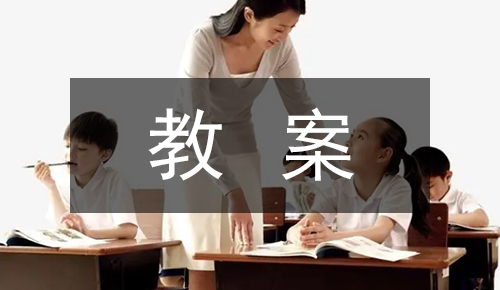
In and of Grade Seven (II), “Go for it!”, studentshave learned “The Simple Past Tense”. And it appears again in of Grade Eight(I). teaches students more about how to talk about events in the past. Inaddition, it gives affirmative and negative statements in the past tense, suchas the sentence patterns “Did you see …?” “Were there …?” “Did you go …?”
As the first part of Unit 8, Section Aopens with a picture presenting the last school trip in the aquarium andcontinues with several step-by-step practice activities, which are all good forstudents to master “The Simple Past Tense”. Doing well in Section A will help studentsintegrate the new target language with that in Section B. Thus, they candescribe the events in the past freely and foster their own ability ofreflecting and practicing.
II. Teaching Objectives
Teaching objective is the beginning andaim of teaching activities. According to the overall goal of the Englishelementary course--- improve students synthetic ability of languageapplication, which should be based on the development of students’ “Languageknowledge”, “Language skills”, “Character building”, “Learning strategies” and“Cross-cultural awareness”. The teaching objectives are described as follows
(I). Knowledge objectives
i. Master the simple past tense ofregular and irregular verbs
ii. Recite the new words and expressionsabout the last school trip in the aquarium, including their
pronunciation and intonation
iii. Master the key sentences and learnhow to talk about the past events
(II). Ability objectives
i. Understand the two dialogues and gainthe information to foster the listening skills
ii. Use the discourse markers to organizesentences together to form a short story and interview others to foster thespeaking skills
iii. Understand the reading material andfind the answers on the wall to foster the reading skills
iv. Write down the correct sentences tofoster the writing skills
(III). Moral objectives
i. Encourage students to think and talkin English through communicative tasks and provide the
students with the chances ofcooperation
ii. Get students to realize theimportance of protecting animals and help them build up the sense of
environmental protection
iii. By visiting the aquarium, encouragestudents to know more about our culture and love our country
III. Teaching important points and difficultpoints
According to thedemands of the curriculum focus---“The Simple Past Tense” is one of the mostimportant tense that students should master, the status and function of thisunit, the teaching importantpoints and difficult points are described as follows
Teaching importantpoints:
(i)The key vocabulary about the animals in the aquarium
(ii)Affirmative and negative statements in the past tense, “Didyou, Were there” questions.
(iii) The ways of talking about the events in the past.
Teachingdifficult points:
(i)Create the situation for students to use “The Simple Past Tense”and the sentence patterns “Did you see …?” “Were there …?” “Did you go …?” freely.
(ii)Find out the answers on the flashcards outside the classroom byunderstanding the questions
on the screen.
(iii)Guide students to make up their own dialogues by interviewing thefamous persons.
IV. Arrangement for the teaching material
David Nunan pointed out that “Don’t use just the textbook.Anything in real life that connect and appropriate to the lesson can be used asteaching resources.” Teachers shoulduse the textbook to teach rather than teach the textbook. McGrath (2002) alsopointed out that the adjustment of the teaching material should be based notonly on the structure of the material itself, but also on students’ learningprocess. So the arrangement should be student-centered. In addition, “Go forit!” emphasizes on “language application” and “cultivating students’ ability ofinnovation and practice”. Curriculum focus lays stress on “Characterbuilding”, “Learning strategies” and “Cross-cultural awareness”. And innovation can help cultivate students’ autonomouslearning and cooperative learning. So, the arrangement for the teachingmaterial is described as follows:
On recycling “The Simple Past Tense”,present some pictures about the recent past events in the world and havestudents describe them instead of asking the question in 1a. On teaching thekey vocabulary, the videotapes and flash are used to attract students’attention. The tasks of “Test your memory” and “Guessing games” are selected onteaching the key sentence patterns “Did you see …?” “Were there …?”and “Did yougo …?” in 3b. The task of interview is to talk something about thelast trip between “reporters” and “famous persons”. The task of “Can you find them out on the wall?” focuseson students’ skills of listening, speaking, reading and writing. Students won’tfind the answers outside on the wall until they understand the reading materialin 3a. And the last task “ Use your imagination” asks students to summarizewhat they have learned, then use “The Simple Past Tense” to make up a story byadding sentences themselves.
Part 2 Teaching Methodologies andLearning Strategies
I.Student Analysis
The students in Grade Eight havelearned how to describe the past events before, though they don’t know muchabout it, they have shown their confidence in learning English. They candescribe the pictures, and exchange their information according to the familiartopic. They are good at imitation, they are eager to show their abilities. So,in this way, students are encouraged to fulfill some small tasks to enhance theability of solving problems through interaction in a target language.
The more advanced students wish tochallenge each other with new vocabulary and create original dialogues usingkey grammar and vocabulary items. The less advanced students may benefit frompairwork and groupwork, because the more fluent students may help them, so theymay have the chance to practise.
II. Teaching Methodologies
i. The Task-based Language Teaching
Thetheoretical background of the Task-based Language Teaching comes frompsycholinguistics. Psycholinguistic perspective is that a task is a device that guideslearners to engage in certain types of information-processing that are believedto be important for effective language use and for language acquisition.Nunan(1989)also pointed out, “Setting specific tasks for students so that theyact as if they were using the language in real life — this is part of theessence of task-based teaching.” In this lesson, I mainly adopt this method tohelp my teaching. For example, six tasks are arranged for students to fulfillthrough interaction in a target language. So students can get more chances tospeak out.
ii. The Communicative Language Teaching
The curriculum focus emphasizes on“learner-centered”. So does “TheCommunicative Language Teaching” proposed by M.Canale and M.Swain whichprovides students lots of information and encourage them to take an active partin it. In the task of interview, by giving students some key sentences, letthem interview the famous persons in groups of two or three according to theirlast trip and their photos. They may use their imagination to make up their newdialogue. It not only enlarges their intellectual circles, but also improvestheir spoken English.
iii. The Direct Method
Berlitz’s Direct Method forbid thefirst language in classrooms, it enables the students to think in the targetlanguage, so that they can use it to express themselves directly withoutreferring to their mother tongue. In this way, concrete vocabulary was taughtby using videotapes, demonstration, objects and pictures. In the first sixminutes, the words “shark, octopus and seal” were taught by using this method.Thus, the use of the target language as a means of instruction andcommunication in the classroom contributes greatly to forming the habit ofthinking in the target language, which is necessary in efficient realcommunication.
III.Learning Strategies
i. To cultivate learners’ autonomous learning.
“Curriculum focus” recommends “The Task-based LanguageTeaching”, which has a specific objective and has meaning as their primaryfocus. In the tasks of “Test your memory” and “Guessing games”, to providestudents some pictures and photos will help them practise the target languageand cultivate their autonomous learning. And the tasks will encourage them totake part in the classroom activities and pay constant attention to expandingtheir language.
ii. To cultivate learners’ cooperative learning.
In the area of “Language skills”, “Curriculum focus”demands that the students in Grade Eight should make up several dialoguesaccording to the topic and give a performance with the teacher’s help. In thetasks of “Interview” and “Can you find them out on the wall?”, by arrangingvarious interaction activities, such as teacher-students, students-students,especially the activities among students, let students communicate with eachother by practicing to stimulate learners’ interests, then cultivate their cooperativelearning and reinforce their learning motivation. Thus, they can help eachother and form the good learning style.
iii. To cultivate learners’ ability of reflecting and practicing.
When thelearners are describing the past events, they will use “The Simple Past Tense”to help them. Thus, it will cultivate their own ability of reflecting andpracticing
IV.Teaching Aids
Besides the textbook and the speechcassette, Internet also provides different kinds of pictures and videotapeswhich will attract students’ attention. Furthermore, students’ own photos, teacher’sgestures, some real objects and the projector will also help the teaching. Onthe other hand, they will help students fulfill their tasks successfully.
Part 3 Teaching procedures
I.Teaching procedures
Teaching procedures
Teaching aims
Pre-task
i. Warming up(3 minutes)(Pictures)
Recycle the “Simple Past Tense” by giving some words and pictures about recent past events in the world. Encourage Ss to describe them by having a competition among them.
ii. Do you know the animals in the aquarium?
(3 minutes)(Videotapes, flash)
Get Ss to watch a short play to teach the animals in the aquarium. ( The key words: aquarium, shark, seal, crab, octopus, shell, starfish, fish)
This activity helps students describe the past events in the world. And the competition is aimed to make them become active.
This activity provides the key vocabulary in Section A, Unit 8. And the short play is interesting enough to attract students’ attention.
While-task
Task One--- Test your memory(3 minutes) (Pictures)
i. Give Ss 30 seconds to remember the 9 pictures on the screen.
ii.Test their memories by using “Were there …?”or “Did you see …?”to ask and answer.
Students like new challenge, so testing their memory will arouse their interest. And this task provides speaking practice using the target language “Were there …?” “Did you see …?”
Task Two--- Guessing games(3 minutes)
(Photos & the projector)
Call out some students with their photos to come to
the front. Get the others to guess where he went for
his last trip by asking “Did you go …?”
Students are curious to know the places their classmates traveled, so this task gives them the chances to use the target language “Did you go …?”
Task Three--- Listening(5 minutes)
(Audiocassette, the recorder)
Have Ss listen to the tape and do the listening exercises on Page 47 & 48. Encourage Ss to give the answers by having a competition among them.
Group 1
Group 2
Group 3
Group 4
This task gives students practice in understanding the target language in spoken conversation. 1b and 2a focus on fluency. They will make students become confident. 2b will challenge the more advanced students.
Task Four--- Interview(10 minutes)
(Photos, the projector)
i Have Ss bring their own photos. The photos should be about their last trips. Ask the students in Group 1 to exchange the photos with the students in Group 2. So does Group 3 & Group 4.
ii Suppose the students in Group 2 and Group 4 are famous persons. Give the students in Group 1 and Group 3 three minutes to interview the famous persons according to the photos.
IiiCall out some to act it out. See who are the best actor and actress.
(Here are some suggestions for the reporters to interview the famous persons.)
I am a reporter from CCTV-9.
Now I am going to interview …,
How was your last trip?
Did you go …? /Where did you go?
Were there …?
What did you do there?
Did you see … there?
Did you buy a souvenir?
Did people there ask for your autograph?
…
This task provides oral practice using the target language.
Students have traveled some places and taken some photos. They have their own opinions about their last trip. So this task is for them to show their abilities of sharing opinions in English. And they are eager to be famous persons, so the task is aimed to motivate them.
Task Five--- Can you find them out on the wall?
(9 minutes)(Flashcards, answer sheets, CAI, the projector)
i Books closed. Show the six questions on the screen. But the answers are on the flashcards outside the classroom.
Students sit in different rows should answer different questions. (Row1-Q1, …,Row 6-Q6)
ii Hand out the answer sheets. Each group just gets one.
Ss sit on the left—Go out of the classroom to find the answers on the wall.
Ss sit on the right—Don’t go out! Just write down the answers by understanding their partners’ explanation.
IiiEvery time, just ask one student from each group to find the answers on the wall outside the classroom.
iv.Check the answers from each group.
See which group has the most correct answers. And which group is the first one to finish the task.
Group 1
Group 2
Group 3
Group 4
v. Have Ss correct the statements on Page 49
This task is new and the competition will help students get involved. In addition, it provides the
students with the chances of cooperation. Finding the correct answers will foster their reading skills. Explaining the answers to their partners will foster their speaking skills. Writing down the answers correctly will foster their listening and writing skills.
In a word, it will develop students’ skills of listening, speaking, reading and writing.
Post-task
Task Six---Use your imagination(3 minutes)
iHave Ss make up their own story. One student starts the story by saying where he went, the others add sentences to continue the story.
ii. Have a competition among them. One sentence, one point. They should use “The Simple Past Tense”. And students who can use the discourse marker can get more points. See which group has the most correct sentences.
Students have different kinds of ideas about the trips. This task helps them use their imagination to share their ideas with others, and it also provides oral practice using the target language.
Summary(1 minute)
Have Ss summarize “the Simple Past Tense” they learned today.
This activity helps Ss know what they have learned in this unit.
Assignment
i Recite the new words and phrases in Section A, Unit 8
IiWrite a composition about your last trip
IiiPreview Section B, Unit 8
The assignment aims to help students recycle what they have learned today and foster the ability of reflecting.
II. Blackboard design
How was your school trip?
I. New words & phrasesII. Sentence patterns
aquarium What did you do …?
SharkDid you …?
seal Yes, I did. / No, I didn’t
OctopusWere there …?
souvenir Yes, there were. /No, there weren’t.
autograph
III. Competition
Group 1 Group 2Group3 Group 4
III. Pre-assessment
In this lesson, formative and summativeassessment are adopted. By letting students fulfill different kinds of tasks tobuild self-assessment and group assessment. And it will do help to students’ autonomous learning and cooperative learning.
But the task of “Interview” may bedifficult for some students. So the teacher may provide some languagestructures or interview a student first to make sure that this activity isgoing on smoothly. And the task of “Can you find them out on the wall?” may benew for the students, so the teacher may give an example first to help studentsunderstand the meaning of the game. The task may make students become crazy. Whensome are going out to find the answers, the others should be in order. And the teachershould make sure that students inside mustn’t be too noisy.
Appendix
Actor/actress____________
A—Excellent!Self-assessment
Group-assessment
Observation assessment
i. Pronunciation and intonation
ii. Asking and answering clearly
iii. Cooperation
iv. Content
v. Creativity
vi. Taking an active part in the activity
vii. Reaction of audiences
viii. Stage properties
B—Good!
C—Not bad!
D—Come on!
How was your school trip?教案二
单元课时安排:5课时
单元目标与要求
1.学习询问和谈论过去发生的事情。如:what did you do on your school trip ? did you go to the zoo? No, Ididn’t.I went to the aquarium.等。
2.能听、说、读、写Section A、B部分中的四会单词和四会句型。
3.能够听、说、读Section A、B部分中的对话。能够听懂简单的听力回答,完成selfcheck 部分的练习。
4.能够掌握动词过去式的构成法。规则动词和不规则动词的一般过去式。一般过去式的肯定句和否定句。Did you were there 引导的一般疑问句。
第一课时
教学内容与分析
1.教学内容:Section A1a, 1b,1c
2.教学目标:
a. 能够听、说、读、写地点名词aquarium, science center, gift shop, museum, 和动物名词dolphin, seal ,shark, octopus。
b.能够听、说、认读句子:what did you do last school trip? Did you go to the zoo? Were there anysharks?并能运用这些句型来描述自己和他人的身高。
1. 能简单进行询问和谈论过去发生的事情。
教学重点、难点分析:
1.教学重点:能够听、说、读、写地点名词aquarium, science center, gift shop, museum, 和动物名词dolphin, seal ,shark, octopus。实际情景中会运用询问和谈论过去发生的事情。
(i)The key vocabularyabout the animals in the aquarium
ii)Affirmative and negative statements in the past tense, “Did you, Werethere” questions.
(iii) The ways of talking about the events in the past.
2.教学难点:对过去的事情进行询问并会简单的描述。Aquarium, souvenir的发音也是本课时的教学难点。
(i)Create thesituation for students to use “The Simple Past Tense” and the sentence patterns“Did you see …?” “Were there …?” “Did you go …?” freely.
(ii)Find out theanswers on the flashcards outside the classroom by understanding the questionson the screen.
(iii)Guide students tomake up their own dialogues by interviewing the famous persons.
课前准备
1.教师准备主情景图的教学课件。
2.教师准备磁带和录音机。
教师设计(过程)
复习(Warm-up/Revision)
1.enjoy the movie (let’s travel)
a. 教师播放录音,师生一起吟唱并观看。
b. 请学生watch the screen进行问答。如:
what did I do yesterday? What did I do on vocation? What did Sam do threedays ago?
2. pairs work:“what did he/ she/ they do on last school trip?”
操练(Presentation/Practice)
1. 教学句型“Did you go to the zoo?”
a. guessing game:” What did Sam do on his last school trip?
T: what did Sam do on his last school trip? Do you know?
S: did he ……..?
2.教学地点名词aquarium, science center, gift shop, museum, 和动物名词dolphin, seal ,shark, octopus。实际情景中会运用询问和谈论过去发生的事情。
a Do you know the animals in the aquarium?
(3 minutes)(Videotapes, flash)
Get Ss to watch a short movie to teach the animals in the aquarium.( The key words: aquarium, shark, seal, crab, octopus, shell, starfish, fish)
b Task One--- Test your memory(3 minutes) (Pictures)
i. Give Ss 30 seconds to remember the 9 pictures on the screen.
ii.Test their memories by using “Were there …?”or “Did you see…?”to ask and answer.
3. pairs work (were there any books in the classroom yesterday? 1c
4..Listening(5 minutes)
(Audio cassette, therecorder)
Have Ss listen to the tape and do the listening exercises on Page 47 1b.Encourage Ss to give the answers by having a competition among them
巩固(Extension/Consolidation)
1. . Interview(10 minutes)
(Photos, the projector)
i Have Ss bring their own photos. The photos should be about their lasttrips. Ask the students in Group 1 to exchange the photos with the studentsin Group 2. So does Group 3 & Group 4.
iiSuppose the students in Group 2 and Group 4 are famous persons. Give thestudents in Group 1 and Group 3 three minutes to interview the famouspersons according to the photos.
IiiCall out some to act it out. See who are the best actor andactress.
(Here are some suggestions for the reporters to interview the famouspersons.)
I am a reporter from CCTV-9.
Now I am going to interview …,
How was your last trip?
Did you go …? /Where did you go?
Were there …?
What did you do there?
Did you see … there?
Did you buy a souvenir?
Did people there ask for your autograph?
2.完成课后相应的练习。
3.Homework
1. 抄写本课时出现的地点名词aquarium, science center, gift shop, museum, 和动物名词dolphin, seal ,shark, octopus。
2. 采访并做好记.
II.Blackboard design
Unit 8How was your school trip?
I. New words & phrasesII. Sentencepatterns
aquarium What did you do …?
SharkDid you …?
seal Yes, I did. / No, I didn’t
OctopusWere there …?
souvenir Yes, there were. /No, there weren’t.
autograph
III. Competition
Group 1 Group 2Group3 Group 4
第二课时
教学内容与分析:
1.教学内容: Section A. 2a 2b 2c 3b
2.教学目标:
a.能听懂,会说:how was your day off? What else did he do? What did you do on…? 并能在情景中熟练运用。
b.掌握一般过去式及词汇autograph ,win jate took, hang out
c.情感教育,尊重他人
数学重难点:
1.本课需要重点掌握句型:.要求学生能替换关键词汇autograph ,win jate took, hang out
掌握一般过去式及词造新句并在实际情景中自如运用。
2.本课时的难点是:一般过去使的运用,规则动词和不规则动词的一般过去式。一般过去式的肯定句和否定句。Di you were there 引导的一般疑问句。
课前准备:
1.本课时的教学课件。
2.相关的录音磁带及录音机。
教学设计:(过程)
复习(Warm-up/Revision)
1. chant
clap, clap, clap, clap our hands,
I say go ,you say went.
Go, go, go, went,went,went.
Buy, buy, buy .bought, bought. bought
Take, take, take,took took took
Eat, eat eat. ate……..
2. revise “ what did he see ?”
A:What day is it today?
B: It’s Monday.
A: what did he see in the aquarium?
3.look at the chart, say out the questions
操练(Presentation/Practice)
1.guessing game。”What did I do yesterday evening?”
2.放2a部分的录音,感知新内容并完成练习。
巩固(Extension/Consolidation)
1.完成配套练习。
2.听2a , 2b 的录音。
3.同学一起练chant.
第三课时
教学内容与分析:
1.教学内容: Section A. 3a 3b 3c
2.教学目标:
a.能听懂,会说:how was your day off ? What did you do on…? 并能在情景中熟练运用。
b.掌握一般过去式及词汇visitor, gift, drive, end, octopus, Chicago
outdoor, off
c.情感教育,尊重他人
教学重难点:
1.本课需要重点掌握句型:.要求学生能替换关键词汇 Class 9 had a great time on the school trip. have a great time/have agood time/enjoy oneself
At the end of the day…掌握一般过去式及词造新句并在实际情景中自如运用。
2.本课时的难点是:一般过去使的运用,规则动词和不规则动词的一般过去式。一般过去式的肯定句和否定句。Di you were there 引导的一般疑问句。
课前准备:
1.本课时的教学课件。
2.相关的录音磁带及录音机。
您可能喜欢的文档
查看更多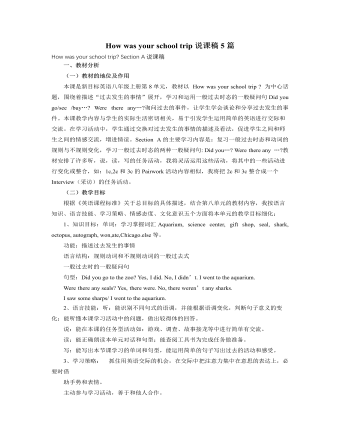
人教版新目标初中英语八年级上册How was your school trip说课稿5篇
- 页数:25页
- |大小:139.50KB

人教版新目标初中英语八年级上册How do you get to school教案2篇
- 页数:38页
- |大小:273.00KB
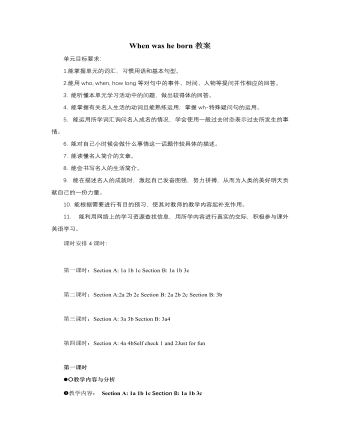
人教版新目标初中英语八年级上册When was he born教案
- 页数:10页
- |大小:73.50KB
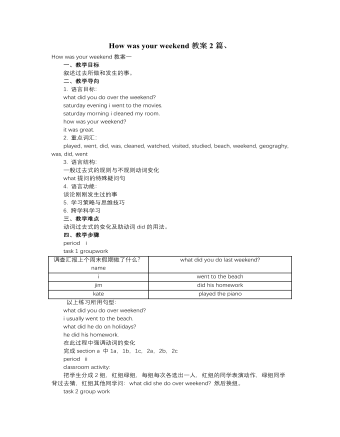
人教版新目标初中英语七年级下册How was your weekend教案2篇
- 页数:5页
- |大小:96.00KB
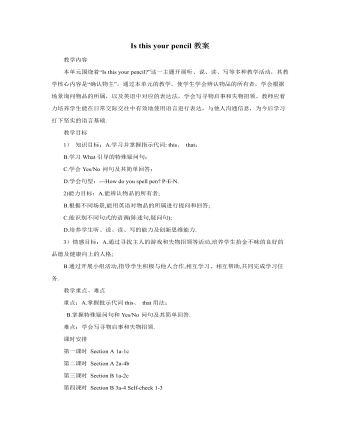
人教版新目标初中英语七年级上册Is this your pencil教案
- 页数:18页
- |大小:94.00KB
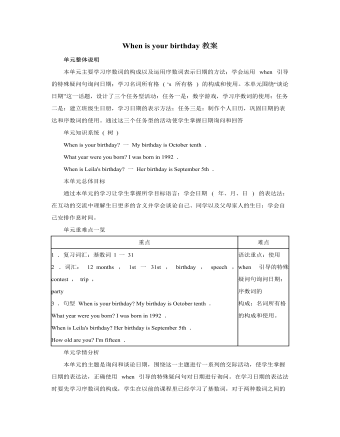
人教版新目标初中英语七年级上册When is your birthday教案
- 页数:15页
- |大小:123.00KB

人教版新目标初中英语八年级上册Could you please clean your room教案3篇
- 页数:18页
- |大小:134.50KB
热门课件教案
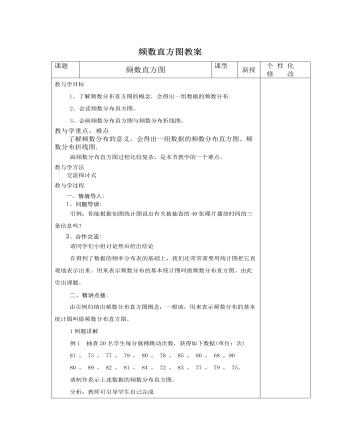
北师大初中七年级数学上册频数直方图教案2
- 页数:5页
- |大小:71.50KB
- 课件教案
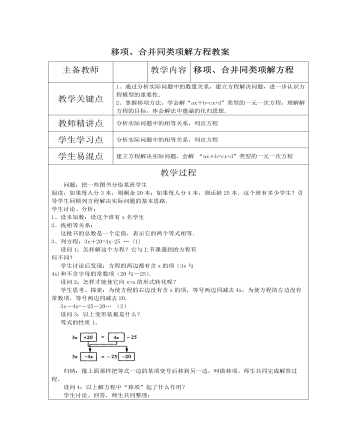
北师大初中七年级数学上册利用移项与合并同类项解一元一次方程教案2
- 页数:2页
- |大小:64.50KB
- 课件教案
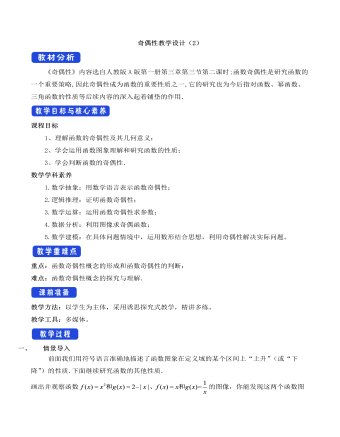
人教A版高中数学必修一奇偶性教学设计(2)
- 页数:7页
- |大小:179.77KB
- 课件教案
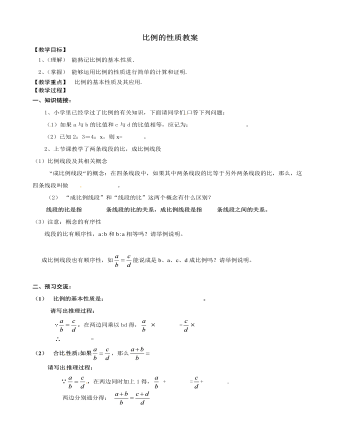
北师大初中数学九年级上册比例的性质2教案
- 页数:2页
- |大小:321.50KB
- 课件教案
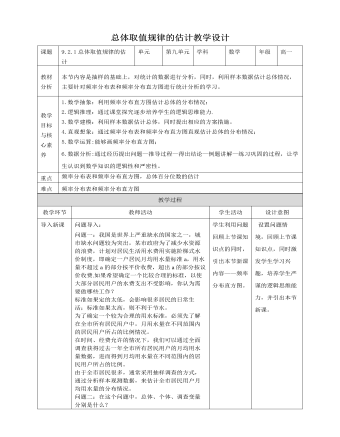
人教A版高中数学必修二总体取值规律的估计教学设计
- 页数:12页
- |大小:821.00KB
- 课件教案

人教A版高中数学必修一诱导公式教学设计(1)
- 页数:9页
- |大小:180.22KB
- 课件教案
今日更新
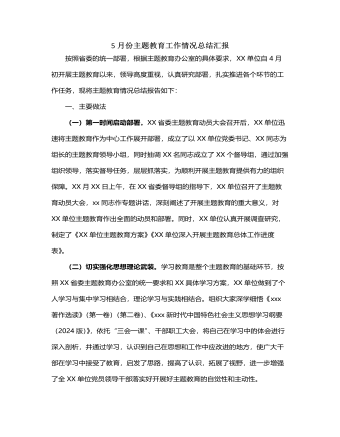
5月份主题教育工作情况总结汇报
- 页数:3页
- |大小:136.87KB

××县招商局2024年上半年工作总结
- 页数:12页
- |大小:142.54KB
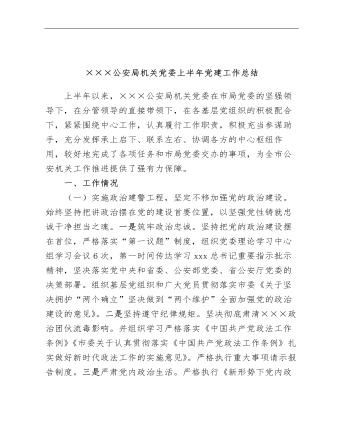
×××公安局机关党委上半年党建工作总结
- 页数:7页
- |大小:186.25KB

《2019—2024年全国党政领导班子建设规划纲要》实施情况的工作总结3800字
- 页数:6页
- |大小:29.16KB
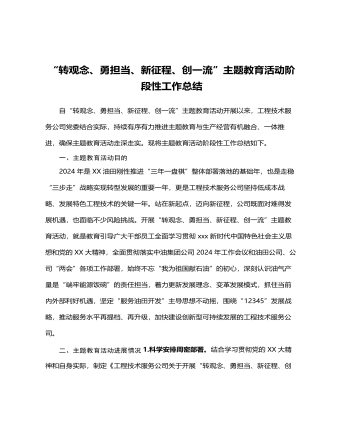
“转观念、勇担当、新征程、创一流”主题教育活动阶段性工作总结
- 页数:3页
- |大小:22.76KB

“四零”承诺服务创建工作总结
- 页数:5页
- |大小:39.83KB





